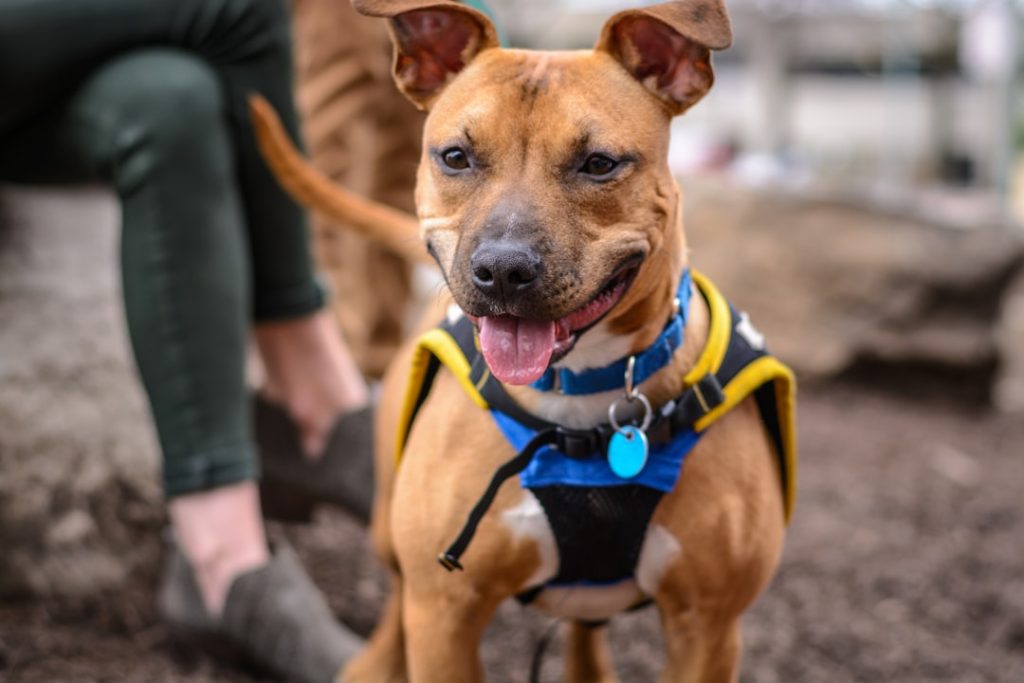Understanding the root causes of dog behavior problems is essential for effective resolution. Many behavioral issues stem from inadequate training, insufficient socialization, lack of exercise and mental stimulation, or poor supervision and management. It’s crucial to recognize that dogs are individuals with unique personalities and needs, and their behavior often reflects their environment and experiences.
Breed-specific traits can also influence behavior. Some breeds may be more prone to aggression, anxiety, or have a high prey drive, while others may require more physical activity. Recognizing these genetic predispositions can help owners anticipate and address potential issues.
Past experiences significantly impact a dog’s behavior. Dogs that have suffered abuse, neglect, or poor socialization may exhibit fear, aggression, or other behavioral problems. Understanding these underlying factors allows owners to approach behavior modification with empathy and patience, creating a positive and supportive environment for their canine companions.
By identifying the root causes of behavioral issues, dog owners can take proactive steps to address problems and foster a harmonious relationship with their pets. This approach involves tailoring training and management strategies to meet the individual needs of each dog, considering both genetic factors and past experiences.
Table of Contents
- 1 Training and Socialization
- 2 Providing Adequate Exercise and Mental Stimulation
- 3 Supervision and Management
- 4 Creating a Safe and Secure Environment
- 5 Using Positive Reinforcement
- 6 Seeking Professional Help
- 7 FAQs
- 7.1 What are some effective ways to keep your dog from killing chickens?
- 7.2 Why do dogs kill chickens?
- 7.3 How can training help prevent dogs from killing chickens?
- 7.4 What are some physical barriers that can be used to keep dogs away from chickens?
- 7.5 What are some signs that a dog may be prone to killing chickens?
Key Takeaways
- Understanding the root of the problem is crucial in addressing behavioral issues in dogs
- Training and socialization are essential for a well-behaved and balanced dog
- Providing adequate exercise and mental stimulation is key to preventing destructive behavior
- Supervision and management play a critical role in preventing accidents and negative behavior
- Creating a safe and secure environment is important for a dog’s overall well-being and behavior
- Using positive reinforcement is an effective way to encourage good behavior in dogs
- Seeking professional help is important if behavioral issues persist or worsen despite efforts to address them at home
The Importance of Positive Reinforcement Training
Positive reinforcement training methods, such as using treats, praise, and play, can help dogs learn desired behaviors while strengthening the bond between the dog and their owner.
Consistency and Patience are Key
Consistency and patience are key when it comes to training, as dogs thrive on routine and clear expectations. Socialization is equally important, as it helps dogs feel comfortable and confident in different situations. Exposing dogs to a variety of people, animals, and environments from a young age can help prevent fearfulness, aggression, and other behavioral issues later in life.
It’s important to introduce new experiences gradually and in a positive manner, ensuring that the dog feels safe and supported throughout the process. Additionally, ongoing socialization throughout a dog’s life can help maintain their good behavior and prevent them from becoming fearful or reactive in new situations. By prioritizing training and socialization, dog owners can set their pets up for success and create a strong foundation for a positive relationship.
Providing Adequate Exercise and Mental Stimulation

Dogs are active, intelligent animals that require both physical exercise and mental stimulation to thrive. Adequate exercise helps dogs release excess energy, maintain a healthy weight, and prevent boredom and destructive behaviors. The amount of exercise needed can vary depending on the dog’s breed, age, and individual energy level, but most dogs benefit from daily walks, playtime, and opportunities to run and explore.
Engaging in activities such as fetch, agility training, or hiking can provide dogs with the physical activity they need to stay happy and healthy. In addition to physical exercise, mental stimulation is equally important for a dog’s well-being. Mental stimulation can come in the form of puzzle toys, training sessions, interactive games, or even scent work.
Providing opportunities for mental exercise can help prevent boredom and alleviate stress or anxiety in dogs. Mental stimulation can also strengthen the bond between a dog and their owner, as it provides opportunities for learning and problem-solving together. By prioritizing both physical exercise and mental stimulation, dog owners can help their pets lead fulfilling lives and reduce the likelihood of behavioral issues stemming from boredom or excess energy.
Supervision and Management
Supervision and management play a crucial role in preventing unwanted behaviors and keeping dogs safe in various situations. Proper supervision involves being attentive to a dog’s behavior and intervening when necessary to prevent them from engaging in undesirable actions. This may include redirecting a dog’s attention, using positive reinforcement to encourage good behavior, or removing them from a situation that may trigger unwanted behaviors.
Additionally, management involves setting up the dog’s environment in a way that prevents them from engaging in problematic behaviors. This may include using baby gates to restrict access to certain areas of the home, using crates or pens for safe confinement when necessary, or using leashes or long lines during outdoor activities. Consistent supervision and management are especially important during the early stages of training and socialization, as well as when introducing a dog to new environments or experiences.
By being proactive in supervising and managing a dog’s behavior, owners can prevent them from practicing undesirable behaviors and set them up for success in various situations. Additionally, proper supervision and management can help keep dogs safe from potential hazards or dangers in their environment.
Creating a Safe and Secure Environment
Creating a safe and secure environment is essential for promoting good behavior in dogs and preventing potential accidents or injuries. This includes ensuring that the home environment is free from hazards such as toxic plants, small objects that could be swallowed, or accessible electrical cords. Additionally, providing a comfortable and secure resting area for the dog, such as a crate or bed, can help them feel safe and relaxed in their home environment.
When it comes to outdoor spaces, it’s important to ensure that the area is securely fenced to prevent the dog from wandering off or encountering potential dangers. Providing adequate shelter from extreme weather conditions is also crucial for the dog’s well-being. By creating a safe and secure environment both indoors and outdoors, dog owners can help their pets feel comfortable and protected while minimizing the risk of accidents or injuries.
Using Positive Reinforcement

Effective Training and Behavior Modification
By using positive reinforcement consistently, dog owners can effectively teach their pets new skills, encourage good manners, and address behavioral issues in a constructive way. This approach also helps build the dog’s confidence and trust in their owner, leading to a more harmonious relationship overall. Positive reinforcement can be used in various training scenarios, such as teaching basic obedience commands, addressing leash reactivity, or modifying fear-based behaviors.
Creating a Supportive Learning Environment
By prioritizing positive reinforcement in training and behavior modification efforts, dog owners can create a supportive and encouraging learning environment for their pets.
Benefits of Positive Reinforcement
Positive reinforcement helps create a strong bond between the dog and their owner, promotes good behavior, and builds the dog’s confidence and trust in their owner, leading to a more harmonious relationship overall.
Seeking Professional Help
In some cases, addressing behavioral issues in dogs may require the expertise of a professional trainer or behaviorist. Professional help can be beneficial when dealing with complex behavioral problems such as aggression, anxiety, or compulsive behaviors that may be difficult to address on one’s own. A qualified trainer or behaviorist can assess the dog’s behavior, identify underlying triggers or motivations, and develop a customized behavior modification plan to address the specific issues at hand.
Additionally, seeking professional help can provide valuable guidance and support for dog owners who may feel overwhelmed or unsure about how to address their pet’s behavioral issues. A professional trainer or behaviorist can offer practical training techniques, behavior modification strategies, and ongoing support to help both the dog and their owner work through challenging behaviors. By seeking professional help when needed, dog owners can gain valuable insights into their pet’s behavior and receive expert guidance on how to create positive changes for their furry companion.
In conclusion, understanding the root of behavioral problems in dogs is essential for addressing these issues effectively. By prioritizing training and socialization, providing adequate exercise and mental stimulation, practicing supervision and management, creating a safe environment, using positive reinforcement, and seeking professional help when needed, dog owners can work towards promoting good behavior in their pets while strengthening their bond with them. With patience, consistency, and empathy, it is possible to address behavioral issues in dogs in a positive and constructive manner, leading to a harmonious relationship between dogs and their owners.
If you’re struggling with keeping your dog from killing chickens, you may also be interested in learning about how long it takes for chicken eggs to hatch naturally. Check out this article for more information on the hatching process and how to care for your chickens during this time.
FAQs
What are some effective ways to keep your dog from killing chickens?
Some effective ways to keep your dog from killing chickens include training your dog to leave the chickens alone, providing proper supervision, using physical barriers such as fences or kennels, and providing enough mental and physical stimulation for your dog to prevent boredom and predatory behavior.
Why do dogs kill chickens?
Dogs may kill chickens due to their natural predatory instincts, boredom, lack of proper training, or lack of supervision. Some dogs may also see chickens as prey or may become excited by the movement of the chickens.
How can training help prevent dogs from killing chickens?
Training can help prevent dogs from killing chickens by teaching them to leave the chickens alone through commands such as “leave it” or “stay.” Positive reinforcement training can also help reinforce good behavior and discourage predatory behavior towards chickens.
What are some physical barriers that can be used to keep dogs away from chickens?
Physical barriers such as fences, kennels, or chicken coops can be used to keep dogs away from chickens. These barriers can help prevent direct contact between the dog and the chickens, reducing the risk of predatory behavior.
What are some signs that a dog may be prone to killing chickens?
Signs that a dog may be prone to killing chickens include a high prey drive, chasing or stalking behavior towards small animals, lack of obedience to commands, and a history of predatory behavior towards other animals. It’s important to address these signs early on through training and supervision.
Meet Walter, the feathered-friend fanatic of Florida! Nestled in the sunshine state, Walter struts through life with his feathered companions, clucking his way to happiness. With a coop that’s fancier than a five-star hotel, he’s the Don Juan of the chicken world. When he’s not teaching his hens to do the cha-cha, you’ll find him in a heated debate with his prized rooster, Sir Clucks-a-Lot. Walter’s poultry passion is no yolk; he’s the sunny-side-up guy you never knew you needed in your flock of friends!







